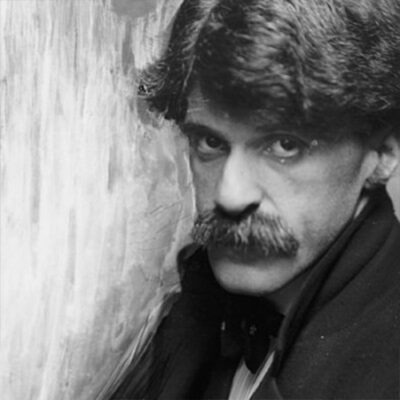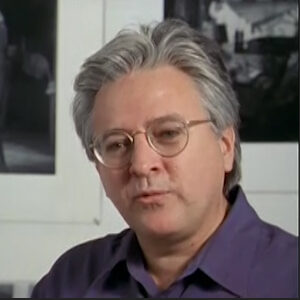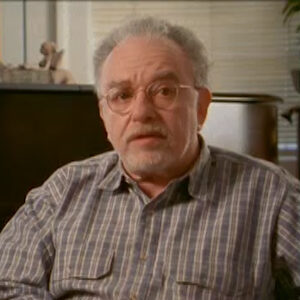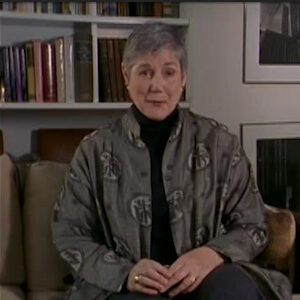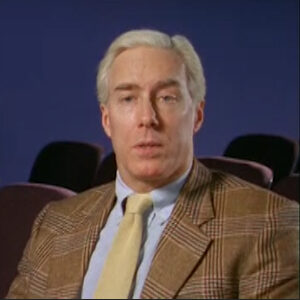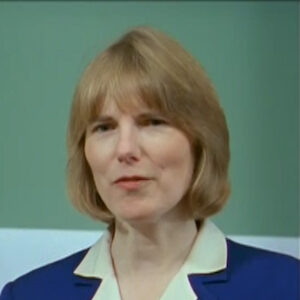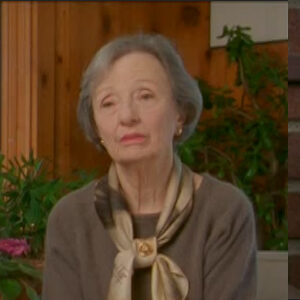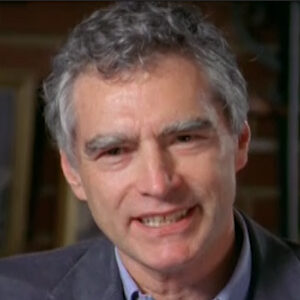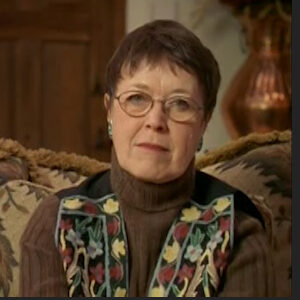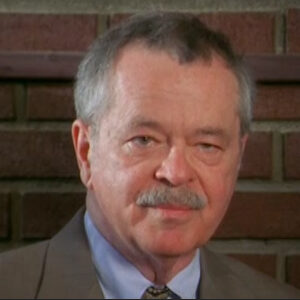Amenoff: I think my first introduction to the artist of the Stieglitz group hardly Dove. Marianne O’Keefe and so forth, probably. I had a little bit of it in art history at the small college I went to in the 60s. But when I made a career choice and became a painter, I think it was it was a series of shows that Barbara Haskell did at the Whitney Museum in New York that I came down for. I was then living in Boston. I came down to New York and in particular, I remember this magnificent Arthur Dove show in 1976 or five sometime in that period. And it really centered me. I think it helped sort of focus my own notion of identity. Being a Midwesterner living on the East Coast and seeing Dove’s work made perfect sense to me and seemed to speak to a lot of the things that I was feeling about my work, but hadn’t quite articulated at that point.
Interviewer: Look at me a little more right when you’re talking. Got it. Don’t do that again using the camera.
Interviewer: No, I think that’s I think that’s good. And what was it that you think that that attracted to you?
Interviewer: I mean, how did. What was it that you felt connected with, particularly in individual?
Amenoff: Right. Well, in terms of these artists that we’re talking about, and I remember very distinctly the dog show, as I said, and a series of other shows, most of which were held at the Whitney, I think it was a very sense of simplicity in terms of the work, the focus of the work. The images were paired down and very simple. Yet they had a relationship to the observed world, but they also had a sense of abstraction at that time. My work, certainly relative to what I do now, was more abstract in character. So I was interested in in these artists in particular, again, Dove and Hartley O’Keeffe, who were certainly among the first American artists to explore abstraction, abstraction in the sense of abstracting from nature, not pure abstraction, but abstracting from the observed world or the experienced world. So these artists then it was the simplicity and the directness. And I think the lack of guile in the work, which is something I admire. These weren’t artists who were strategic, nor were they artists who were involved with ideology. They were operating very directly off of fundamental experiences, few of them, as a matter of fact, regardless of their sophistication. And they were all incredibly sophisticated. Most of their great work was done outside of New York, which I find very interesting, and not being a native New Yorker. I found that somewhat reassuring, although I did live here and have lived here for 20 some years, so.
Interviewer: That’s very interesting. Could you talk a little bit about nature and the connection with with with with nature? Right.
Interviewer: What I think is remarkable and I think often overlooked in the artists of the Stiglitz circle in particular. Is the their engagement with natural form and with natural beauty as a kind of vessel for or made perhaps a replacement for religious themes or spiritual themes?
Amenoff: It’s certainly not an original idea. But the 19th century is the defining century in terms of creating an equation between the natural landscape of this continent and sort of notions of transcendence and matters of the spirit.
Amenoff: This you can see all the way through the Hudson River school painters, the luminous painters of the late 19th century, carried through into Albert Pinkham, Ryder, and then later given full form, I think O’Keeffe and Hartley and Marion and so forth, the artist that we’re talking about.
Amenoff: I think nature was first seen as as the most potent source of imagery. They additionally had the benefit of modernism, which was just being born to abstract from that nature and then to inject it with I to my mind.
Amenoff: They injected this natural form with a kind of spiritual presence, a kind of simplicity and a kind of reverence and perhaps reverie, if I can say that that was, I think, unusual at the time and not a European sensibility, I might add, one that was unique to this continent.
Interviewer: Could you talk a little bit about the American politics that that you that you brought up just now?
Amenoff: To my mind, the driving presence in the art world, certainly around the turn of the century, was European driven. Of course, Picasso was inventing cubism.
Amenoff: There were dozens of isms come off of symbolism, impressionism and on and on, full vision and more ideological isms like futurism and so forth, although there was an influence, certainly on American artists. From those movements, because they were dominant movements, international movements, in fact, began to become the international style. There was something particular. Again, to my mind that members of the Stieglitz circle did when they translated those isms, those ideological movements, all of whom had all of which had tenants that were usually written describing the nature of the movement. When the American artists absorbed these ideas, in particular the artists of the Stieglitz circle. Translated them in a much more. I’m going to use a word I’m it’s a little silly perhaps, but in a homespun way. They took it back to a very fundamental related it directly to a very fundamental gaze of the American landscape. And that was internalized, thereby internalizing, I should say, internalizing the the ideological elements. So the ideology fell away. And but be the force and permission that those idealized ideologies gave had full flower in the work. Returning to a much more, as I said, guileless, direct. And I have to say, somewhat innocent view. Not a jaded view, certainly, nor an over sophisticated view of the natural landscape. But a notion of simplicity, I think.
Interviewer: Do you think the. The American landscape was put to harm.
Amenoff: For example, at Mars that hardly in particular found, although he did paintings in the in the teens and in the 20s that were influenced by these European movements that we’re talking about, the German officer paintings, which ironically are the most high at the Hale.
Amenoff: Given that. Which ironically, are valued the most of all of Hartley’s work. Yet the real core of Hartley’s work.
Amenoff: I think without doubt and certainly strongly from my point of view, occurred when he was in Maine painting the Maine coast, painting the New Mexican coast, painting on his trips to Mexico. But certainly at the end of his life. All in Maine. The Maine coast in Dog Town and all the great paintings he made of the fishermen of the Eastern Seaboard. Those are the paintings, which are the defining paintings from Mars than Hartley, where his degree of sentimentality, a certain physical sense of abstraction, but great pleasure in the rocks, the water, the fish, the birds, the logs, all those issues seem to come full flower in his late work.
Interviewer: Did he make you jealous? That he was.
Amenoff: Now, my biography in terms of where he was actually born, you’re going to mess me up here because I’m not sure. I can’t remember.
Amenoff: Yeah, yeah, yeah. Hartly was a maner. Yeah, I should know that. I’ve read his biography, but I.
Interviewer: What do you think are some of the essential the essential characteristics of the work of some of these Stieglitz artists? And how do you what do you think feel that you your work you share with them?
Amenoff: To me, the the essential characteristics and these are things I experienced 25, 30 years ago for the first time in their work, was their relationship to nature and a direct vision of nature. The translation and the addition of abstraction to kind of render a very pure sense of of that natural experience without the detail more of an internalized sense of things. What struck me twenty five years ago and continues to move me is a shared relationship with that natural form. I’m Midwestern. I’m from a small town in Illinois. I grew up in the cornfields moving out east. In a sense, like any artist in exile, I’m able to see that experience very clearly. Understanding hardly. Dove, O’Keefe, Marin and other artists of that same period has helped me to focus exactly on what I value from my own history. And it’s that shared sense of some really fundamental notion of nature, of a direct experience and direct vision, perhaps somewhat exaggerated, somewhat visionary. These are things that I find attractive. I think the submersion of religious or spiritual notions in those natural forms is also something I find attractive that I have continued to work in and around in even the newest work that I’m doing.
Interviewer: Do you connect this with with American art? And how would you connect this with with it, with American art?
Interviewer: About the American, not the search for an American art and how these Stieglitz artists connected with that.
Amenoff: I think that this group of artists in particular, again, Dove and hurriedly O’Keefe. We’re all certainly aware and affected by the many movements that were going on in Europe in the early part of the century. But what is exciting and very interesting about what Stieglitz made possible was to make a home for a notion that regardless of these influences and these very exciting revolutionary ideas about what picture making could be, what art could be, that there was indeed something about the American character that needed to find a home and needed to find a focus. And by providing that with a stable of artists, supporting them and promoting them, I think it gave the artists confidence to return to something that was much more homespun, much more homegrown. Dove lived many of his years on a houseboat in a very simple way, working from just available materials, in some cases collage materials, things that were just found in the American landscape, looking at things as diverse as a sunset or a landscape or an oil derrick. These were things that they found central to the American character and I think ultimately was the real power and permission that Stieglitz gave them all. O’Keefe, of course, found her great inspiration in northern New Mexico. That was certainly a landscape that was profoundly connected with this continent. A very dramatic landscape certainly had little to do with any of the influences that were prevailing more on the East Coast in terms of European art. So to my mind, these artists all return to something or worked out of something that was very central, very simple, and was profoundly American, profoundly connected even to this hemisphere. Quite distinct from ideas that are popular that continue to be popular, for instance, in Europe. I think that, in fact, one looks at the European landscape now, and these are artists in terms of the art world. These are all artists who have never received their due. O’Keefe, to a certain extent, has received some acclaim in Europe. But for the most part, I think that the impulse that drove these artists is really something that Americans understand more than any other people. This they are legitimately operating out of a very local sensibility. One, I have to say I don’t believe is any less great. I think it’s a profound and driving notion, these connection of art and nature, the lack of guile, the innocence, these connect to ideas much more that are profoundly American. For instance, Emmerson, Abraham Lincoln, who Hartly greatly admired Whitman. These are the artists. These are the writers and the poets that had a profound influence on these on the sensibility that was American.
Interviewer: Right. OK. OK.
Amenoff: I think that these artists are part of a chain of ideas that certainly aren’t without some European influence, but are still much more profoundly connected to our country, in particular, Emerson Thoreau moving through Abraham Lincoln, whom Hartly greatly admired, moving into Walt Whitman, of course. And then contemporaneous with Whitman, you have Albert Pinkham, writer, the father, to my mind again, of American modernism, of American painting, really in this century. You have Albert Ryder carrying these ideas, this direct vision, this very simple forged form vocabulary. Carrying it right into then Dove Hartley O’Keeffe, all of whom admired not only these writers and poets, but certainly a painter like Albert Pinkham, writer. Good. Good.
Interviewer: How do you feel that this. This connects with you. You feel that this isn’t right?
Amenoff: Well, I think that in terms of O’Keefe, it’s interesting in my own work, not so much in the foreign vocabulary, but I happen to spend time in New Mexico virtually in the same landscape within ten or fifteen miles of where Mr. O’Keefe was spent her last days in in Albuquerque, New Mexico.
Amenoff: So I’m attached to her work, mostly through a shared love for that particular landscape, which I still spend all my summers there in terms of Dove and Hartley. I think it’s much more of formal connection. That is, there’s a form vocabulary and a vision of the world that I find very, very attractive. And I’m hoping in my work and I hope I have extended that tradition into the late 20th century and into the 21st century. It’s not a sensibility that I think I can parrot or am I interested in mimicking, but one that I hope I can extend, perhaps fraught with some of the anxiety of the late twenty 20th century and the early 21st century. And certainly my own personality. My own upbringing. But certainly it is that it is it is the relationship to nature, a sense of abstraction and a sense of the miraculous that I find active in in all of those artists. And to a certain extent, with Hartley in particular, a kind of sentiment that I that I share, not a popular notion in the art world, but certainly he had a sentimentality and a sense of sadness. I find that very attractive, actually, in terms of color. Certainly the greatest colorist of of the artist that we’re talking about. I see Marianne is somebody profoundly involved with the structure of vision and a form, but not essentially a colorist, hardly no art, nor is he a colorist, really. O’Keefe to a certain extent, but still preoccupied with forms. Doug, who is the great colorist of the group and the sense of of.
Amenoff: I want to say generosity in his color is something that certainly affected me when I was, you know, in my early 20s and I continue to find fascinating and find again and overlap with my own sensibility.
Interviewer: Good. Yeah.
Interviewer: Could you tell us a little bit about when you first got interested in the artists of the sprinklered circle and that’s your Stieglitz, so we know what we’re talking about.
Amenoff: I first became aware of the Stieglitz circle. And these artists, Dove Hartley, Marianne O’Keefe and so forth, a little bit in an art history survey class at the college I went to in the Midwest in the 60s. However, issues of American art were certainly not dominant in the survey. So it wasn’t until the early 70s, in middle 70s, when Barbara Haskell put on four or five incredibly clear and rejuvenating exhibitions at the Whitney Museum. I was living in Boston at the time and I came down to see them. They were amazing to me because they reaffirmed. Something I felt inside of myself, the direction of my the indicating that I may cut that hold out. I can get this again.
Interviewer: Tell me what the shows were. Yeah. Got it. He did the show. Got it. Right.
Amenoff: We got in the early 70s, Barbara Haskell put on a series of exhibitions of American artists, in particular the Stiglitz circle, that were astounding. I was coming down from Boston. I remember very well seeing the Arthur Dove show, which was a huge retrospective. The first retrospective at that time during my lifetime.
Amenoff: And it was an amazing show. It had a profound influence on me insofar as it gave me permission to follow a direction that my work seemed to be taking on its own. I found a correspondence. And again, exhibitions like that by historical figures can give you permission to continue to validate. I should say, the path that you might be on already. The other exhibitions, one on Hartly, I remember in particular, I believe there was one on Marrin. I think the O’Keefe exhibition came a little later, but these exhibitions had an extraordinary influence in that way. I was a Midwestern boy living in Boston and later moving to New York, felt somewhat in exile from where I was from. And these exhibitions kind of helped me focus on what my attribute was, which is that I was from the cornfields, I was from the Midwest. There was something fundamental about the nature of the land there that I was interested in. Yet those ideas were unformed. So it was my experience. And seeing these exhibitions in the 70s, early 70s, that really allowed me to pursue that direction, which was just beginning to germinate in the work.
Interviewer: I need you to mention that you didn’t mention it.
Amenoff: Yes, I did. I think I did mention that with me. Right. OK, I’ll just start the sentence and then you can run it in.
Amenoff: It was in the early 70s that Barbara Haskell at the Whitney Museum in New York put on a series of exhibitions of the Stieglitz group, not as a group, but individual retrospectives, in particular the Dove retrospective. And I believe 1976 I was living in Boston. I came down to see those shows one after another, and they reaffirmed something that I sensed in myself but hadn’t yet produced work, which was fully realized in this way.
Interviewer: What did you feel? What did you feel? The nature of abstraction. It would be nice. Got it.
Amenoff: In these exhibitions of Hartley, Dove and so forth, there was evident it was evident to me that there was a confluence of preoccupation with natural form, but also that notion of abstraction, that permission to abstract and to simplify, to reveal in essence about that experience. Certainly, many of these artists were at the very beginning of abstraction in our century. Arthur Dove in particular, along with Kandinsky in Europe.
Amenoff: This permission, although at that point it was a 70 year old idea, was something that I found reassuring and so far as my work was much more abstract than it is now. But I was able to engage more natural form.

